DENNIS KUCINICH VOWS TO END ALL OIL AND GAS DRILLING IN OHIO IF ELECTED GOVERNOR AND THEN TAKE THE INDUSTRY TO COURT by Zaid Jilani, February 19 2018, The Intercept
THE MAN WHO saved Cleveland — and paid the ultimate political price for it — now wants to do the same for Ohio.
Dennis Kucinich, the boy mayor of Cleveland who went on to serve nearly two decades in Congress, is running for governor on a platform of radical change to how the energy industry operates in the state.
“Fresh water and clean water are not negotiable issues,” Kucinich told The Intercept, pointing to the water contamination associated with oil and gas drilling. “They’re not negotiable.”
In a press conference in late January, the Ohio Democratic gubernatorial candidate unveiled one of the most cutting-edge environmental platforms of any candidate in the country. Kucinich called for a total end to oil and gas extraction in the state of Ohio.
To accomplish this, he would deploy a battery of radical policies. He would, for instance, utilize eminent domain to seize control of oil and gas wells throughout the state and then shutter them. He would block all new drilling permits and order a total ban on injection wells.
Kucinich would also deploy the Ohio State Highway Patrol to stop and turn away vehicles that possess fracking waste.
Under a Kucinich administration, Ohio would give subsidized health screens to residents living near fracking sites; that data would then be used to file a class-action lawsuit against fracking companies similar to how states took Big Tobacco to court in the ’90s.
The former Ohio member of Congress made his mark in the state’s politics when he was elected mayor of Cleveland at the age of 31, making him the youngest mayor of any major city in America. His tenure was marked by a bitter fight over the city’s electric utility, Cleveland Public Power. A number of banks invested in the utility’s private competitor refused to roll over the city’s debt. This resulted in the city defaulting on its debt, making it the first major city in America to default since the Great Depression. But Kucinich’s battle to save the electric utility paid off for the people of Cleveland — the utility rebounded and continued to offer cheaper power than its private competitor. (His battle with private interests was so fierce that at one point the city’s mafia put out a hit on him when he announced the decision to re-bid private contracts.)
Industry is less than happy about Kucinich’s plan, to say the least.
A spokesperson for the Ohio Chamber of Commerce, which represents a number of oil and gas companies, derided the plan in an interview with The Intercept. “Misguided policies such as these threaten Ohio’s future and would destroy billions of dollars invested in our communities,” the spokesperson said. The organization has promoted an analysis that argues Ohio could lose 400,000 jobs by 2022 if the state enacts a ban on fracking.
Mike Chadsey, a spokesperson for the Ohio Oil and Gas Association, was even harsher in an interview with the local media.
“For being the person who touts himself as the candidate for the average guy, he sure is anti-worker and anti-union,” [Pfffffffffffffffffffffffft! Feeble arguments used also by Alberta politician and union-massager Rachel Notley to feed fear and greed and fool the super foolish and ignorant into sticking with polluters and abusers!] Chadsey said. “These bold and unrealistic statements show how desperate his hopeless campaign is.”
When asked about the economic concerns from the chamber, the candidate was blunt about the tradeoffs.
“No one has taken the time to monetize the value of fresh water, but ask the people in Flint about that,” he replied.
It is worth pointing out that Kucinich is not totally ambivalent about employment in the state of Ohio.
He is also campaigning on investments in public works projects — such as spending more money on basic infrastructure and constructing a statewide public broadband network.
In interviews with The Intercept, environmental activists in Ohio and across the country praised Kucinich’s approach.
… Others suggested Kucinich go further. Carl Sterner — a Cincinnati architect who has been active in the 2030 Districts project, which aims to build sustainable urban spaces — said the candidate should do more to directly promote renewable energy.
“I think Kucinich has the right objective,” he said.
“Fracking’s dangers to public health and the environment are extensive and well-documented, and the state absolutely should intervene to protect Ohio’s communities. But he needs to think bigger. I would like to hear more about the positive actions he intends to take to promote efficiency and renewable energy and make Ohio a leader in clean energy manufacturing. Ohioans need a positive vision to rally around, and I don’t see this in Kucinich’s environmental platform.”
… The organization has created an interactive map charting the routes of major pipelines in Ohio. It notes that these pipelines are within close proximity of over 200 schools, over 150 medical facilities, and three dozen drinking water intake pipes.
Lea Harper, managing director of the Ohio-based FreshWater Accountability Project, conceded that some believe Kucinich’s plan isn’t politically viable, but countered that the expansion of fracking in Ohio is too destructive to ignore.
“People are saying [Kucinich’s plan is] unrealistic, but what’s unrealistic is that fracking is going to continue as it has and it’s going to be OK.
It’s about time someone came out to expose the industry for what it’s doing to our environment and to people,” she said.
Kucinich is competing against four other Democrats, including former Consumer Financial Protection Bureau chief Richard Cordray, for the nomination. In interviews conducted with the local press, none of the others joined his call to eliminate fracking and oil drilling. “It is rash. It is naive,” former State Rep. Connie Pillich said. “It will take years and will be marred with legal battles and taxpayers are going to have to pay those legal fees.”
Ted Auch, a Cleveland State University professor who works with the monitoring group FracTracker Alliance, met with Kucinich recently to discuss his proposal. While stressing that his group is nonpartisan and does not endorse candidates, he was encouraged by Kucinich’s approach.
He said that most Democrats and Republicans have generally viewed fracking as a means to create jobs and tax revenue, but have ignored environmental and public health costs. “He plans to inject a far more granular discussion or perspective into the debate about fracking in the state of Ohio,” he said of Kucinich’s plan.
The primary is May 8. [Emphasis added]
[Refer also to:
2018 02 19: Day 3: Powhatan Ohio residents remain displaced; XTO Fails to Contain Methane Leak
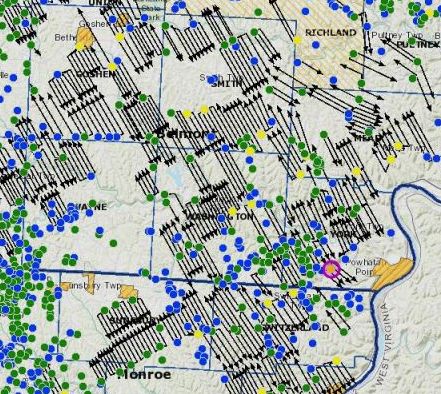
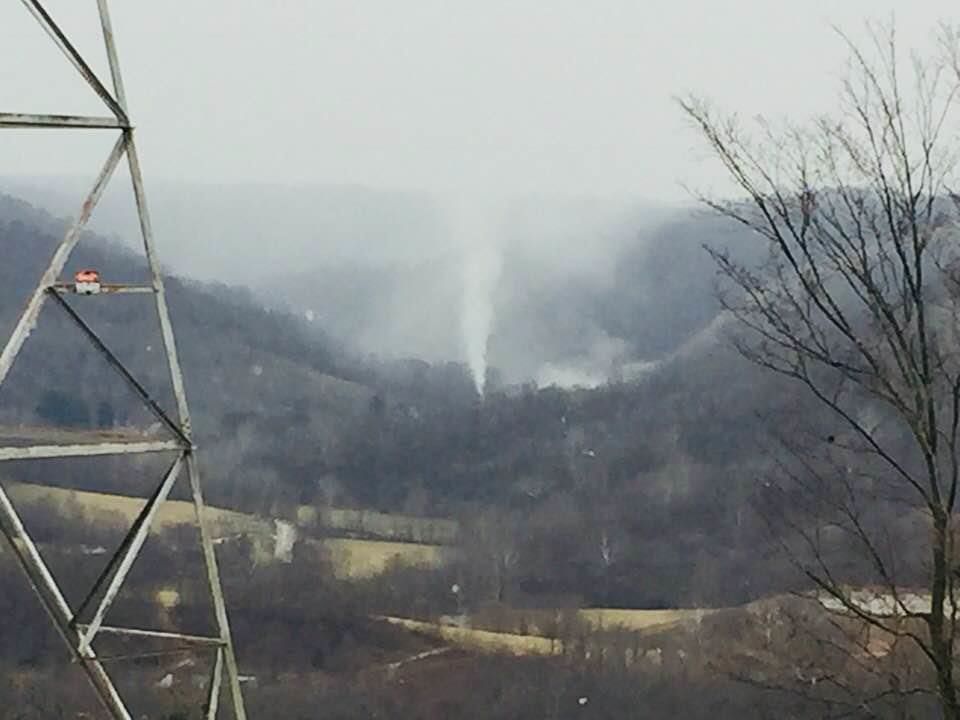
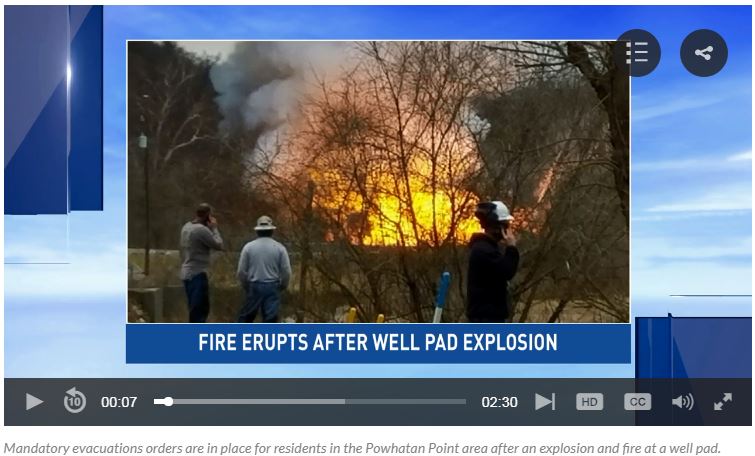
Near XTO’s Powhatan explosion/out of control well: 2018 07 28: EPA Investigation report details toxic chemicals at 2014 Statoil Frac Site Explosion; Chemicals spilled into Opossum Creek – 70,000 fish killed; Ohio Regulator says safe to drink the water
2014 06 28-29 U.S. ENVIRONMENTAL PROTECTION AGENCY POLLUTION/SITUATION REPORT Statoil Eisenbarth Well Response
1.1.2.2 Description of Threat
Over 16 different chemicals products were staged on the Pad at the time of the explosion and subsequent fire. Materials present on the Pad included but was not limited to: diesel fuel, hydraulic oil, motor oil, hydrochloric acid, cesium-137 sources, hydrotreated light petroleum distillates, terpenes, terpenoids, isoproponal, ethylene glycol, paraffinic solvents, sodium persulfate, tributyl tetradecyl phosphonium chloride and proprietary components. As a result of fire-fighting efforts and flow back from the well head, significant quantities of water and unknown quantities of products on the well pad left the Site and entered an unnamed tributary of Opossum Creek that ultimately discharges to the Ohio River. Runoff left the pad at various locations via sheet flow as well as by two catch basins located at the northwest and southeast corners of the well pad.
[After Encana frac’d Rosebud’s drinking water aquifers in 2004, diols and kerosene range hydrocarbons were found by Alberta Environment in Rosebud Hamlet drinking water that bypassed the new reservoir. These toxics were ignored by the regulator in their final report. The most common diol used in the oil and gas industry is ethylene glycol. Eight years later, Encana and the regulators still have not disclosed if Encana injected ethylene glycol in its operations above the Base of Groundwater Protection around Rosebud; no chemicals injected have as of yet been disclosed to the public, except for the promise of “hospital grade Nitrogen only.” Encana will not disclose if its frac flow back or wastes are radioactive, not even after dumping waste repeatedly on farm land close to the Hamlet]
1.1.3 Preliminary Removal Assessment/Removal Site Inspection Results
…
Initial reports identified the following products were involved and lost in the fire: ~250 gallons of hydrochloric acid (28%), ~7,040 gallons of GasPerm 1000 (terpenes, terpenoids, isopropanol, citrus extract, proprietary components), ~330 gallons of LCA-1 (paraffinic solvents), ~ 1900 gallons of LGC-36 UC (hydrotreated light petroleum distillate, guar gum), ~1000 gallons of BC-140 (monoethanolamine borate, ethylene glycol), ~3300 gallons of BE-9 (tributyl tetradecyl phosphonium chloride), ~30,000 gallons of WG-36 (polysaccharide gel), ~1,000 gallons of FR-66 (hydrotreated light petroleum distillate), ~9000 gallons of diesel fuel, ~300 gallons of motor and hydraulic oil.Additionally, there was an inventory of shaped charges, primer cord and detonators on the site as well as three Cesium-137 radiological sources (2-100 millicurie and 1-55 millicurie) with unknown disposition as a result of the fire.
[Shaped charges are used in perforating explosives]
ODNR Division of Wildlife completed their in stream assessment of the fish kill and reported an estimated 70,000 dead fish from an approximately 5 mile stretch extending from the unnamed tributary just west of the Eisenbarth Well Pad to Opossum Creek just before its confluence with the Ohio River. No fish kills were reported on the Ohio River.
Water samples of runoff indicated the presence of TPH, 2-butanone, acetone, benzene, xylenes, toluene, bis(2-ethylhexyl)phthalate, 1-methylnapthalene, 2-methylnapthalene, o-Cresol, m&p Cresol, naphthalene, phenol, and chlorides. Surface water sampling results indicated the presence of TPH, acetone, bis(2-ethylhexyl)phthalate, phenol and chloridesdownstream of the well pad.
[Bis(2-ethylhexyl)phthalate was found by Alberta Environment in the Hamlet and Ernst’s drinking water. The regulator found naphthalene range hydrocarbons, and an increase by a factor of 45 of chromium in the Ernst water. Barium and Strontium doubled. These red flag petroleum industry indicators were ignored by the regulator and research council (now Alberta Innovates)]
… Surface water sampling results indicated the presence of TPH, acetone, bromodichloromethane, chloroform, bis(2-
ethylhexyl)phthalate and chlorides downstream of the well pad.
Plans to assess surround drinking water wells are being developed. Statoil has previously sampled all wells within 5,000 feet of well head prior to commencing operations.
OEPA and USEPA were provided, by Halliburton, the constituents of the proprietary component of GasPerm 1000. Evaluation of these constituents indicates that current analytical techniques being used with the addition of reporting tentatively identified compounds (TICs) will be sufficient for assessing off-site impacts. Fish recovery efforts continued on the unnamed tributary to Opossum Creek and Opossum Creek. Fish, crayfish and salamanders are being recovered. …
Halliburton began unloading the remaining quantity of FR-66 from the tanker truck. A leak was detected in the bottom valve on the tank
…
The burning tank containing WG-36 was smothered by pumping Barite (barium sulfate) into the top of the tank. External temperatures dropped throughout the day. Halliburton continued to recover FR-66 from the tanker truck and from pooled areas against the southeast corner of the earthen berm … In total, 11,116 dead fish were collected (20 different species), 3,519 crustaceans, 7 frogs and 20 salamanders.
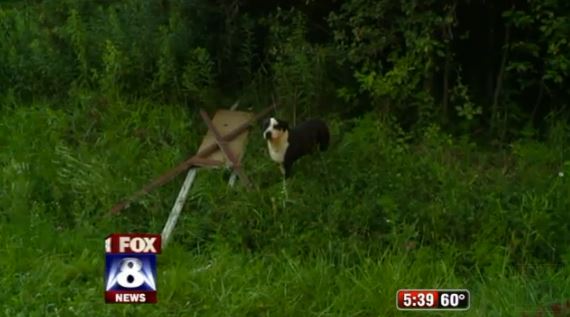

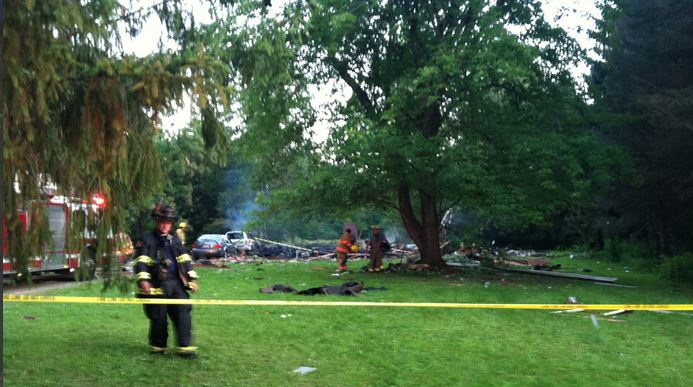

2014 06 30: Fish kill in eastern Ohio might be linked to fire at Statoill’s fracking well
2014 02 27: Ohio: Fracking Leads to Cracks in Home Foundation and Water Contamination
2013 08 19: Fracking Linked To 109 Earthquakes In Youngstown, Ohio
2013 03 16: Well explodes in eastern Wayne County, Ohio
2013 02 12: Bainbridge Ohio residents deal with contaminated water from drilling
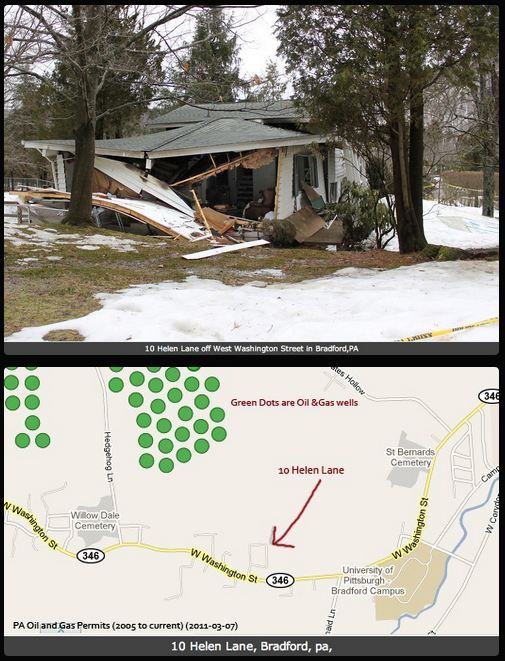
2013 02 11: Ohio EPA official: Lupo dumped drilling waste at least six times
2013 02 07: Ohio revokes permits of two firms tied to illegal Youngstown dumping
2012 08 01: Cincinnati Becomes First Ohio City to Ban Fracking Injection Wells
2012 07 11: Ohio Governor Signs Executive Order Prohibiting Oil and Gas Drilling in Lake Erie
2012 06 06: Water Sales to Fracking Industry Stopped in Southern Ohio
2012 05 29: Ohio passes one of the worst fracking laws in the U.S. ]

